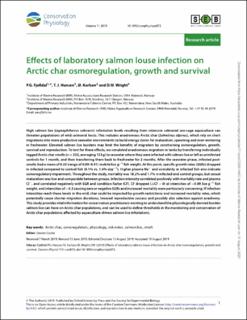| dc.description.abstract | High salmon lice (Lepeophtheirus salmonis) infestation levels resulting from intensive salmonid sea-cage aquaculture can threaten populations of wild salmonid hosts. This includes anadromous Arctic char (Salvelinus alpinus), which rely on short migrations into more productive seawater environments to build energy stores for maturation, spawning and over-wintering in freshwater. Elevated salmon lice burdens may limit the benefits of migration by constraining osmoregulation, growth, survival and reproduction. To test for these effects, we simulated anadromous migration in tanks by transferring individually tagged Arctic char smolts (n = 352, averaging 133 g) to seawater where they were infected with salmon lice or left as uninfected controls for 1 month, and then transferring them back to freshwater for 2 months. After the seawater phase, infected post-smolts had a mean of 0.33 (range of 0.09–0.91) mobile lice g−1 fish weight. At this point, specific growth rates (SGRs) dropped in infected compared to control fish (0.1% vs. 1.6% day−1). Higher plasma Na+ and osmolality in infected fish also indicate osmoregulatory impairment. Throughout the study, mortality was 18.2% and 1.7% in infected and control groups, but sexual maturation was low and comparable between groups. Infection intensity correlated positively with mortality rate and plasma Cl−, and correlated negatively with SGR and condition factor (CF). CF dropped (ΔCF < 0) at intensities of >0.09 lice g−1 fish weight, and intensities of >0.3 causing zero or negative SGRs and increased mortality were particularly concerning. If infection intensities reach these levels in the wild, char could be impacted by growth restrictions and increased mortality rates, which potentially cause shorter migration durations, lowered reproductive success and possibly also selection against anadromy. This study provides vital information for conservation practitioners wanting to understand the physiologically derived burden salmon lice can have on Arctic char populations, and can be used to define thresholds in the monitoring and conservation of Arctic char populations affected by aquaculture-driven salmon lice infestations. | en_US |
